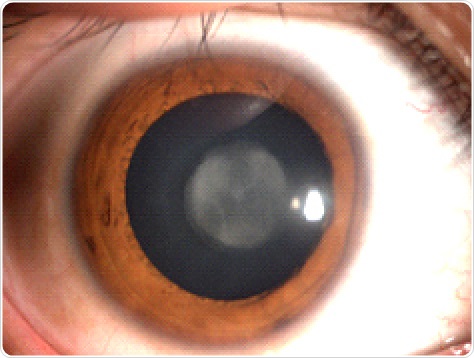Cataracts are whitish or cloudy patches that develop in a person’s eye lens and lead to blurred or clouded vision. Cataracts are the most common cause of visual impairment worldwide.

Cataracts can develop in one or both eyes and interrupt the flow of light through the lens. The lens is usually transparent, allowing light to pass though to the retina at the back of the eye. Cataracts, however, cause the lens to become opaque and as the cataracts grow in size or number, vision gradually worsens, as less light is able to penetrate the lens.
Eye anatomy
The eye is composed of the following structures:
- Eyeball: This is filled with a jelly like material called the vitreous humour
- Conjunctiva: The thin lining covering the sclera (white of the eye)
- Cornea: The clear, transparent layer over the pupil that lets in light
- Lens: The transparent structure at the front of the eye through which light passes
- Retina: A thin nerve membrane located behind the lens that detects light passing into the eye. Nerves in the retina send signals to the brain via the optic nerve to create an image.
- Optic nerve: This carries the information from the retina to the brain so information can be interpreted into vision
- Sclera: The tough covering of the eyeball or the white of the eye
- Uvea: This is the vascular middle layer of the eye ball made up of the iris, the ciliary body and the chorid
- Orbit: This is the cavity that houses the eyeball
Symptoms and risk factors
One of the earliest symptoms of cataracts is blurred vision. The cloudier the lens becomes, the more sight is impaired, until vision in the affected eye is lost altogether. There is usually no pain associated with the condition.
Cataracts usually affect the elderly but children and infants may also be affected by special forms of cataracts. Some of the other risk factors associated with cataracts include smoking, a history of cataracts in the family, poor diet, overexposure of the eyes to sunlight, long-term use of steroids and diabetes.
Treatment
For mild cataracts, high power glasses and brighter reading lights may help. As the condition progresses however, the eye may need to be operated on. Surgery is one of the most popular and most effective treatment options in cataract therapy. The operation involves removal of the affected lens, which is replaced with an artificial lens.
Sources
- www.nhs.uk/conditions/cataracts-age-related/Pages/Introduction.aspx
- http://www.nei.nih.gov/health/cataract/webcataract.pdf
- www.nccah-ccnsa.ca/…/vision_cataracts_web.pdf
- http://www.aoa.org/documents/CPG-8.pdf
- http://whqlibdoc.who.int/bulletin/2001/issue3/79(3)249-256.pdf
Further Reading
- All Cataract Content
- What Causes Cataracts?
- Cataract Classification
- Cataract Treatment
- Cataract Epidemiology
Last Updated: Feb 26, 2019

Written by
Dr. Ananya Mandal
Dr. Ananya Mandal is a doctor by profession, lecturer by vocation and a medical writer by passion. She specialized in Clinical Pharmacology after her bachelor's (MBBS). For her, health communication is not just writing complicated reviews for professionals but making medical knowledge understandable and available to the general public as well.
Source: Read Full Article
